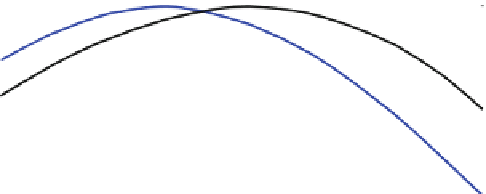Agriculture Reference
In-Depth Information
100
0
increasing bulk density of dry soil in g per l, relative
Fig. 7.1
Principal relation between soil bulk density and grain yield (From Hakansson et al.
1974
,
altered)
defi ned on a longterm basis,
i.e.
for decades and centuries.
Weather
is a matter of
smaller areas and shorter time spans. Very important is the forecasting. The climate of
an area is fairly constant. Forecasting therefore hardly is a problem. Yet forecasting
the weather for more than a few days still is a problem in large parts of the world.
Therefore, adapting the soil cultivation to the respective climate has been state of the
art for a long time. A global traveller attentive to farming operations will notice that in
humid regions the primary cultivation is done deeper than in regions with low rainfall.
This is, because in humid areas the water supply of the crop seldom is a problem, but
the soil aeration often is. In areas with low rainfall, the situation is
vice versa
, conse-
quently here the cultivation is either very shallow or even left out completely.
But what about the adaptation of the
cultivation depth
to short term weather
expectations? Ideally the farmers would have to provide for a high bulk density in a
dry growing season and
vice versa
in a wet year (Fig.
7.1
).
Despite the fact that many weather satellites now operate in combination with
modern computers programs, the
weather forecasts
still are not reliable beyond a
few days. Much better adapted cultivation could be realized, if in the future the
forecasts were accurate for at least some weeks.
An alternative approach would be adapting the depth of cultivation not to the
precipitation expected in the next days but instead to the respective
water content
in the soil. This would be a response to the rainfall and the evaporation of some days
of the past
.
Sensing techniques for recording the water content in the soil are avail-
able (Chap.
5
). The problem is that the depth of primary cultivation is expected to
have its effect over the whole growing season of the crop. Hence the incidental
water content just at the time of cultivation may not always be a reliable indicator
for the best depth of cultivation. Increasing the depth of cultivation with the water
content of the soil might even be completely wrong, if the tools do not break up any
more but instead of this deform and compact the wet plastic soil. Cultivating deep
in regions with a humid climate still might be reasonable, but this should preferably
be done during dry spells in order to prevent damage to the soil.







